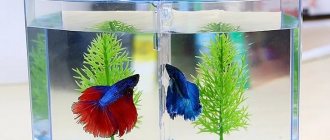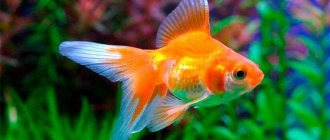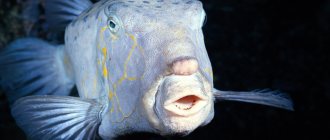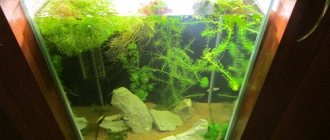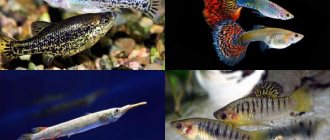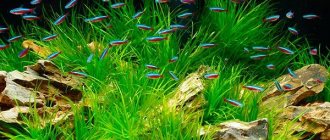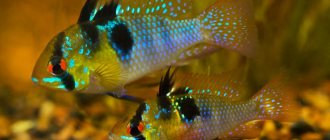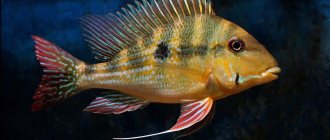Choosing inhabitants for a small aquarium is a whole science, since choosing inhabitants who will be comfortable in a limited space is not so easy. Each type has its own requirements for water hardness, lighting, design, and it can sometimes be very difficult to combine them. The article suggests getting acquainted with the most popular and easy-to-keep fish for a small home.
Endler's guppy
Endler's guppies are colorful small aquarium fish. The body length of males does not exceed 2.5 cm, females - 4 cm. The color of males depends on the morph and can include red, orange, golden, yellow, black, lilac, blue, indigo and green shades. Females have a uniform silver or golden color.
Endler's guppies are kept in aquariums with a volume of 20 liters or more in schools, in which there are 2-3 females per male. The species is viviparous, easily reproduces in captivity, unpretentious, lives at a temperature of 20-28°C, pH 6.5-8.5 and dH up to 25°, but does not like sharp fluctuations in water parameters and excess nitrogen compounds in it. Suitable for feeding are crushed dry food containing spirulina, as well as small live and frozen food - cyclops, daphnia, artemia.
Dwarf Corydoras (Pygmy, Hastatus, Habrobus)
It is also advisable to supplement nano aquariums with bottom inhabitants, which will help clear the bottom of food debris and create movement in the lower part of the aquarium. Dwarf corydoras are ideal for this, because the largest size they can grow to is 2-3 cm. These are the smallest known aquarium catfish. Please note, however, that these species love oxygenated water, good currents and room for swimming, so it is still recommended to take a larger aquarium for them.
Danionella dracula
Danionella dracula is a small fish, the distinctive feature of which is its lower jaw extended forward. In males, it has a pair of long teeth protruding beyond the oral cavity, which is how the species got its name. The size of adult individuals does not exceed 1.5 cm. The body is transparent, internal organs are visible through the skin. A yellow stripe runs along the body at the level of the spine, and the head is also yellow.
Danionella are kept in groups of 10 individuals in aquariums with a volume of 40 liters or more. It can be kept together with other species of similar size. Danionella thrives at a temperature of 20-26°C, pH 6.5-7.5 and dH 2-5°. The species does not like bright light and strong currents. Danionellas are fed with any food of suitable size.
Pros of mini aquariums
The advantage of a mini-aquarium is that anyone can have one. It is inexpensive, and the space requirements are so minimal that almost anyone can find a place for a tiny aquarium. Even a student in a college dorm, a hospital patient, schoolchildren in a classroom, and, of course, residents of small apartments. Fish are very interesting and pleasant to watch; for a child, this may be the first pet that he will look after if it is not yet desirable to have large animals.
Formosa
Formosa are small aquarium fish from the Poeciliidae family. The size of the male does not exceed 2 cm, the female – 3.5 cm. The color is silver-gray, there is a wide horizontal black stripe on the sides, and a black spot on the dorsal fin.
They contain Formosa in schools of 10 or more in aquariums with a volume of 20 liters or more. The fish are unpretentious, preferring a temperature of 22-26°C, pH 6.5-7.5 and dH up to 15°. Frequent water changes are not required, but the reservoir must have good filtration. Formosa can live in brackish water. The species loves bright lighting and thickets of plants, prefers to stay in the upper and middle layers of water. Formosa fish are capable of jumping out of the tank, so the aquarium must be covered with a lid.
Top 20 fish for small aquariums
There are an infinite number of small fish - it’s impossible to list them all - but aquarists have different tastes and preferences, and, as you know, there is no arguing about tastes. We have made a selection of fish, in our opinion, the most miniature and interesting for keeping in small aquariums (5-15 liters). Some of them are very beautiful, others are interesting in their behavior, others are not demanding in terms of maintenance, and others can do without using the usual filters and compressors in the aquarium. This selection is a kind of Top 20 of the most purchased miniature fish in our store, compiled on the basis of consumer demand.
Popondetta furcatus (Pseudomugil furcatus)
These small, silvery, peaceful fish have wing-like fins with a distinct yellow edge. They get along well with other active, peaceful species and usually form a school with other similar-sized fish, such as zebrafish. They are not recommended to be kept with slow-moving fish such as angelfish and gouramis, and the number of females in a school should be greater than males. They take food in the upper and middle layers of water. Popondetta furcata's diet should consist of small flakes and granules, as well as live or frozen brine shrimp, daphnia, cyclops and other small foods.
Microassortment Erythromicron (Danio erythromicron)
These small fish are colored blue-green with vaguely defined vertical stripes on the sides and lead an active schooling lifestyle. This sociable fish prefers to stay in the company of its own kind: the group should consist of at least 6 individuals. Due to their small size, aquarium mates must be chosen carefully. Their food should be appropriate, such as small granules, crumbling flakes, daphnia, cyclops and brine shrimp.
Pseudomugil gertrudae
These are small and slender fish with large iridescent blue eyes. They lead an active peaceful lifestyle and inhabit the middle layers of water. The container for keeping them must have a lid, since these fish can jump well and can jump out of the aquarium. These fish are best kept in groups of at least 6 or more fish, with more females than males. Gertrude's Pseudomygils can be kept with dwarf corydoras, as well as small peaceful tetras and rasboras. They can be fed most types of small foods, including flakes and pellets, plus live and frozen foods such as brine shrimp and daphnia.
Dwarf honey gourami: gold and red (Colisa chuna)
These peaceful gouramis can be kept with small, peaceful aquarium mates. Males become aggressive towards each other when females are present in the aquarium. These fish periodically swim to the surface to swallow air. They have a labyrinth organ and without access to atmospheric air gourami cannot survive. They usually stay in the upper layers of the water, although they often scan the bottom of the aquarium in search of pieces of food. The current in the aquarium should be weak, and shelters should also be necessary, as sometimes honey gouramis can be shy. These fish will readily eat most types of food, including pellets and flakes, as well as live or frozen foods such as daphnia and brine shrimp.
Endler's guppy (Poecilia wingei)
Modern breeds of Endler's guppies are not inferior in variety of colors to the common guppies Poecilia reticulata. Endler's guppies are smaller in size and can be kept in small spaces without much difficulty. A flock of 3-5 individuals can fit into a five-liter aquarium. Equipment you will need is a filter and/or compressor. Endler's guppies will happily eat good dry and frozen food. Live plants will improve the water parameters in the aquarium and reduce stress in the fish.
Southern Afyosemion (Aphyosemion australe)
These small fish get along well with other small, peaceful fish and, as a rule, prefer to stay in pairs. Males of this species do not always get along well with each other, so it is not recommended to keep more than one male in an aquarium, but it is possible to keep one male with two females. The aquarium should have many shelters in the form of clumps of plants in different layers of water, as well as dark soil. Southern aphiosemions eat most flake and granular foods well, but especially prefer live and frozen foods: bloodworms, tubifex and brine shrimp.
Dwarf tetraodon (Carinotetraodon travancoricus)
The dwarf tetraodon, although a baby, is still a ball fish with all the ensuing consequences. With their miniature size (about 2 centimeters), these tetraodons are cocky and inquisitive. If you have shrimps and snails in your aquarium, then after some time there will be neither one nor the other left, and the fins of slow-moving fish will always be bitten. Many people purchase dwarf tetraodons to combat overgrown snails. Having settled into the aquarium, the tetraodontics will begin to watch the owner with their large eyes and beg for food. They love to eat small live and frozen food: tubifex, brine shrimp and cyclops.
Nannostomus beckfordi
Usually these fish are peaceful, but the males drive away and scare away all strangers from their territory. It is better to keep them in groups, ideally 10 individuals or more, so that intraspecific aggression is dispersed among all members of the group, and then these fish will become less timid and begin to show their most natural behavior. Corydoras and any peaceful characin fish will keep them in good company - except Carnegiellas: they will pursue the latter. The aquarium should include dark soil and dense vegetation. Optimally, their food should consist of small granules flavored with daphnia and brine shrimp.
Little goby (Brachygobius doriae)
A tiny goby can liven up the bottom of a small aquarium, decorated with live plants and shelters. Just like the dwarf tetraodon, this fish prefers food of animal origin. Males can show aggression towards fellow tribesmen, but aggression decreases when kept in groups. Baby gobies can spawn under normal conditions if there is shelter. After spawning, the male remains to care for the eggs, and the female loses all interest in the offspring. Baby gobies are a good option for those who want to get offspring from unusual fish in small quantities.
Norman's Aplocheilichthys (Poropanchax normani)
A characteristic feature of these small fish are their bright blue eyes. Norman's Aplocheilichthys lead a peaceful lifestyle and prefer to gather in flocks, swimming in the water column. Bright light is undesirable for them, while dim lighting combined with a pale-colored substrate brings out the color of their eyes well. These sociable fish feel good in the company of their own kind. They have a calm and peaceful disposition, and get along well with other small, peaceful fish. Feeding should be twice a day and consist of flakes, granules, frozen and live foods such as daphnia and brine shrimp.
Corydoras pygmaeus
Everyone is accustomed to considering Corydoras as bottom-dwellers. But corydoras pygmies swim in a flock throughout the aquarium. It is better to form a flock of at least five individuals. Like ordinary corydoras, they can spawn in a home aquarium. They love to dig in the ground, looking for leftover food, however, additional feeding will not hurt them. These small, cheerful fish are a good option for those who do not like fights and other problems in the aquarium.
Betta fish (Betta splendens)
This is a classic of the genre for keeping fish in a limited volume. Cockerels are very beautiful, undemanding when it comes to feeding, and can tolerate unfavorable living conditions and the lack of aquarium equipment. But it should be remembered that the better the conditions, the longer the fish will live and the happier it will be. Keeping only one person, one aquarium - one cockerel. The cost of a cockerel depends on the shape of the fins and color.
Iriatherina werneri
Perhaps, only in small volumes and in the presence of minimal flow, the dances of two males of this species can deliver true aesthetic pleasure. Among all freshwater fish, Werner's Iriaterinas probably have the most fantastic fins. When the males, colored in their nuptial plumage, flap their luxurious fins, they look incomparable and look like bright moths. For this fish, the presence of living plants or mosses is important. Males and females can be kept in one flock. Small frozen and dry food is suitable for them as food.
Cherry barb: simple and veiled (Puntius titteya)
These small barbs have long been one of the most popular fish in the world. They prefer privacy and can act a little nervous in the presence of their conspecifics and other fish species. However, when kept in a mixed group of males and females, as well as in the presence of plants and dark soil in the aquarium, the cherry barb shows its best - bright red - colors. They can be kept with schools of other small fish. Flake, granular, live and frozen food suits them well as food.
Simple otocinclus (Macrotocinclus affinis)
These little sucker fish are amazing scavenger fish. They get along well with other small, peaceful fish, and prefer to stay close to the company of their relatives. Therefore, it is recommended to keep them in numbers of at least 3, and even better – 6 individuals. In nature, their groups number in the thousands. The aquarium must be planted with plants. They can be offered blanched vegetables as food: carrots, zucchini, potatoes and cucumbers, as well as specialized dry algae food in the form of plates.
Microrasbora galaxy
One of the most desirable fish among owners of small aquariums. The small size is compensated by bright colors and interesting behavior. Prices for this fish remain consistently high due to difficulties in breeding and the continued popularity of galaxies. For trouble-free maintenance, the aquarium should be decorated with live plants and mosses, no sudden changes should be made, and water parameters should not be allowed to change. Erythromicron microrasboras can become good neighbors for them: slightly more modest in color, but similar in behavior.
Dario dario
These fish are very close relatives of the badis badis, but are smaller in size. The bright outfit of males, red with blue splashes, contrasts with the modestly colored females. Male dario defend their territory, often located in thickets of plants or near some kind of shelter. In an aquarium with Dario dario, life is constantly in full swing: the fish are either sorting things out, or hiding, or looking for something tasty. These are beautiful and very rare guests in aquariums.
Epiplatys annulatus
If you want to have an aquarium that is completely devoid of any equipment, Epiplatis are the fish for you. However, to successfully keep these fish, living plants - mosses and vegetation floating on the surface - and moderate feeding are necessary. The water must be warm, clean and stable in its chemical composition. Epiplatis usually swim in the upper layers, but juvenile brine shrimp can be hunted throughout the aquarium. These are very beautiful and calm fish.
Brigitte's rasbora (Boraras brigittae)
Rasbora brigitta is one of the smallest fish that can be found on sale. The keeping is gregarious, the males are bright red, the females are a little more modest. It is often written that these fish are difficult to keep, but this is not entirely true. If the aquarium has stable parameters, a lot of living plants, a gentle current, moderate varied feeding, then the fish are not difficult to keep. Don’t change a lot of water at once, don’t create a “storm in a glass” with powerful filters, don’t feed more than necessary and everything will be fine. These fish are more for lazy aquarists: the less they are disturbed, the better.
1st place Neon blue (Paracheirodon innesi)
These small tetras are active schooling fish. The most comfortable way is to keep them in a flock of 6 or more individuals: when kept in a flock, they show their best colors. It is desirable to have plants in the aquarium, as well as dark substrate and driftwood to imitate their natural habitat. The water must be clean and changed regularly. They generally eat well all types of small live, crushed or flake foods. When well maintained, neons have increased resistance to disease and live up to 10 years.
Neon
Neons are small schooling fish. The body size of females does not exceed 4 cm, males are somewhat smaller. A blue stripe runs along the body, capable of refracting light, thereby creating a glowing effect. In some species, under the blue stripe there is another one - red or black.
Neons are kept in groups of 8 or more in aquariums with a volume of 50 liters or more. Fish feel comfortable only in large schools; Living alone or in pairs causes stress and illness. Neons do not like fresh water, so they should be placed in an aquarium with an already established biobalance. Optimal conditions for these fish: temperature 23-25°C, pH 5.5-5.7, dH 8-10°. Neons are fed with food floating in the water column; fish prefer live and frozen food.
Microassortment of erythromicron
Microrasbora erythromicrons are small aquarium fish. The size of adult individuals does not exceed 3 cm. The body color is orange-pink with a large number of wide vertical dark blue stripes on the sides, the fins are reddish.
Microbreeding is kept in groups of 10 individuals in aquariums with a volume of 30 liters or more, planted with plants. Fish prefer a temperature of 21-25°C, pH 7-8 and dH 5-12°. Lighting should be moderate. Filtration, aeration and regular water changes are necessary. They feed the microbill with any food of a suitable size: dry feed mixtures, cyclops, daphnia, brine shrimp. The species has a peaceful disposition and gets along with neighbors of a similar size.
Minuses
Like any aquarium, a small one will need regular maintenance, and you shouldn't buy it with the idea that it will be ignored for a long time. On the contrary, the smaller the aquarium, the more regular maintenance is required, and if any problems arise, they quickly lead to the death of the population before you have time to fix something. The fact is that in a small volume of water in which fish live, changes in the chemical composition and temperature can occur within several hours, and even several minutes. Therefore, it is very important to carefully monitor the condition of the water and conscientiously perform regular water changes.
It is very important to be careful after introducing fish into a new nano aquarium. The amount of toxins in the water increases sharply, and the biological system is just starting to work. If you do not change the water on time, the level of contamination will become fatal very quickly. It is highly advisable to test your water at this stage, so you should have water testing kits on hand.
Cherry barb
The cherry barb is a calm, peace-loving fish. The size of adult individuals does not exceed 4 cm. The color is cherry-red, a narrow black stripe runs along the body, and the back is brown.
Cherry barbs are kept in groups of 6 or more in aquariums with a volume of 50 liters or more. Fish prefer a temperature of 22-24°C, pH 6.5-7 and dH up to 15°. Cherry barbs love tanks filled with plants and dim lighting. In bright light, barbs become shy and hide in the thickets most of the time. Cherry barbs prefer old water; Once a week it is necessary to replace no more than 1/5 of the volume. Live and frozen food (daphnia, cyclops, bloodworms), dry feed mixtures and plant supplements are suitable for feeding.
Tetradon dwarf
Dwarf tetradons are small aquarium fish that live in fresh water. Their body dimensions do not exceed 3 cm. The shape of the body is round, the eyes are large, and horny plates are located in the oral cavity. The color is olive-yellow with large dark spots.
Tetradons are kept in schools of 5-6 pieces in aquariums with a volume of 30 liters or more. Fish prefer a temperature of 24-27°C, pH 6.6-7.7 and dH 5-22°. The species is sensitive to the presence of nitrogenous compounds in water; good filtration with low flow, aeration and weekly changes of 1/3 of the volume are required. Tetradons are predators; They feed on snails, insects and small crustaceans. They can eat smaller fish, and the fins of large species are torn off.
Neoheterandria elegans
Neoheterandria elegans is a viviparous fish from the Poeciliidae family. The body length of adult males does not exceed 2 cm, females - 2.5 cm. The color of the body is golden with a large number of vertical narrow black stripes on the sides.
Neoheterandria are kept in groups of 7 specimens in aquariums with a volume of 30 liters or more. This species is not as unpretentious as other Poeciliaceae; prefers a temperature of 24-30°C, pH 7-8 and dH 5-26°. The water must be clean, so the aquarium must be equipped with a good filter, as well as weekly changes of 1/3 of the volume with fresh water. Fish love densely planted tanks. They feed on any dry, live or frozen food of suitable size.
Lemon tetra
Lemon tetras are colorful little aquarium fish. The size of adult individuals does not exceed 4 cm. The body color is lemon yellow, the iris of the eyes is red, the fins have a black edge.
Lemon tetras are kept in flocks of 5 or more in aquariums with a volume of 35 liters or more with a water temperature of 23-25°C, pH 6-7 and dH up to 15°. Filtration, aeration and weekly changes of 1/4 volume with fresh water are required. Tetras are energetic, active and not shy, so they always remain in sight. The fish are peaceful and can get along with any sized neighbors; they are well suited as inhabitants of a community aquarium. Tetras are not picky when it comes to feeding and will eat any food of a suitable size.
Check-in rules
Many types of small fish are unpretentious, but this does not mean that comfortable conditions should not be created for them.
Before moving in, make sure that:
- The water temperature corresponds to what the fish need.
- You have food that suits the purchased species.
- The water in the aquarium is clean and the filter is working properly.
- The water maintains the correct alkaline balance.
Cardinal
Cardinals are unpretentious, peaceful fish. The body size of representatives of the species does not exceed 4 cm. The body is brown, the belly is light, the mouth, tail and fins are red, on the side there are two longitudinal stripes - a shiny bluish-orange and a black one underneath.
Cardinals are kept in flocks of 5 or more individuals in aquariums with a volume of 40 liters or more. Fish prefer water with a temperature of 22-25°C, pH 6.5-7 and dH 20°. Cardinals love bright lighting and planted ponds, stay in groups mainly in the middle layers of water and are not inclined to hide. The aquarium must be equipped with a filter and an aeration system. Cardinals are non-aggressive and are suitable for a community aquarium stocked with peaceful species of similar size.
The size of the aquarium dictates its conditions
A small aquarium is considered to be less than 50 liters. So, even in a 10-liter miniature pond you can put fish. However, it is worth calculating your efforts; the fewer liters, the more often you need to clean, monitor water quality and aeration. If you plan to keep tropical breeds in a small aquarium, then you will have to maintain the optimal temperature for keeping them, about 26-27 degrees.
In akavirums with a volume of less than 10 liters, this is very difficult to do, since the devices are large in scale and will not physically fit there. Ignoring these conditions will also not work. Without them, the fish you paid more than $100 for will die.
